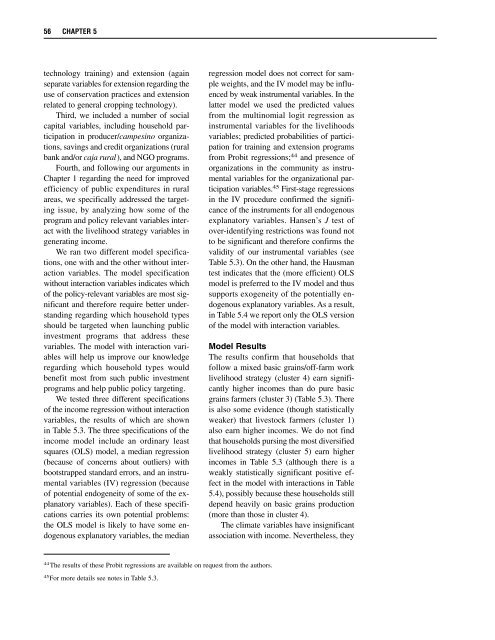Rural Development Policies and Sustainable Land Use in the ...
Rural Development Policies and Sustainable Land Use in the ...
Rural Development Policies and Sustainable Land Use in the ...
You also want an ePaper? Increase the reach of your titles
YUMPU automatically turns print PDFs into web optimized ePapers that Google loves.
56 CHAPTER 5<br />
technology tra<strong>in</strong><strong>in</strong>g) <strong>and</strong> extension (aga<strong>in</strong><br />
separate variables for extension regard<strong>in</strong>g <strong>the</strong><br />
use of conservation practices <strong>and</strong> extension<br />
related to general cropp<strong>in</strong>g technology).<br />
Third, we <strong>in</strong>cluded a number of social<br />
capital variables, <strong>in</strong>clud<strong>in</strong>g household participation<br />
<strong>in</strong> producer/campes<strong>in</strong>o organizations,<br />
sav<strong>in</strong>gs <strong>and</strong> credit organizations (rural<br />
bank <strong>and</strong>/or caja rural), <strong>and</strong> NGO programs.<br />
Fourth, <strong>and</strong> follow<strong>in</strong>g our arguments <strong>in</strong><br />
Chapter 1 regard<strong>in</strong>g <strong>the</strong> need for improved<br />
efficiency of public expenditures <strong>in</strong> rural<br />
areas, we specifically addressed <strong>the</strong> target<strong>in</strong>g<br />
issue, by analyz<strong>in</strong>g how some of <strong>the</strong><br />
program <strong>and</strong> policy relevant variables <strong>in</strong>teract<br />
with <strong>the</strong> livelihood strategy variables <strong>in</strong><br />
generat<strong>in</strong>g <strong>in</strong>come.<br />
We ran two different model specifications,<br />
one with <strong>and</strong> <strong>the</strong> o<strong>the</strong>r without <strong>in</strong>teraction<br />
variables. The model specification<br />
without <strong>in</strong>teraction variables <strong>in</strong>dicates which<br />
of <strong>the</strong> policy-relevant variables are most significant<br />
<strong>and</strong> <strong>the</strong>refore require better underst<strong>and</strong><strong>in</strong>g<br />
regard<strong>in</strong>g which household types<br />
should be targeted when launch<strong>in</strong>g public<br />
<strong>in</strong>vestment programs that address <strong>the</strong>se<br />
variables. The model with <strong>in</strong>teraction variables<br />
will help us improve our knowledge<br />
regard<strong>in</strong>g which household types would<br />
benefit most from such public <strong>in</strong>vestment<br />
programs <strong>and</strong> help public policy target<strong>in</strong>g.<br />
We tested three different specifications<br />
of <strong>the</strong> <strong>in</strong>come regression without <strong>in</strong>teraction<br />
variables, <strong>the</strong> results of which are shown<br />
<strong>in</strong> Table 5.3. The three specifications of <strong>the</strong><br />
<strong>in</strong>come model <strong>in</strong>clude an ord<strong>in</strong>ary least<br />
squares (OLS) model, a median regression<br />
(because of concerns about outliers) with<br />
bootstrapped st<strong>and</strong>ard errors, <strong>and</strong> an <strong>in</strong>strumental<br />
variables (IV) regression (because<br />
of potential endogeneity of some of <strong>the</strong> explanatory<br />
variables). Each of <strong>the</strong>se specifications<br />
carries its own potential problems:<br />
<strong>the</strong> OLS model is likely to have some endogenous<br />
explanatory variables, <strong>the</strong> median<br />
regression model does not correct for sample<br />
weights, <strong>and</strong> <strong>the</strong> IV model may be <strong>in</strong>fluenced<br />
by weak <strong>in</strong>strumental variables. In <strong>the</strong><br />
latter model we used <strong>the</strong> predicted values<br />
from <strong>the</strong> mult<strong>in</strong>omial logit regression as<br />
<strong>in</strong>strumental variables for <strong>the</strong> livelihoods<br />
variables; predicted probabilities of participation<br />
for tra<strong>in</strong><strong>in</strong>g <strong>and</strong> extension programs<br />
from Probit regressions; 44 <strong>and</strong> presence of<br />
organizations <strong>in</strong> <strong>the</strong> community as <strong>in</strong>strumental<br />
variables for <strong>the</strong> organizational participation<br />
variables. 45 First-stage regressions<br />
<strong>in</strong> <strong>the</strong> IV procedure confirmed <strong>the</strong> significance<br />
of <strong>the</strong> <strong>in</strong>struments for all endogenous<br />
explanatory variables. Hansen’s J test of<br />
over-identify<strong>in</strong>g restrictions was found not<br />
to be significant <strong>and</strong> <strong>the</strong>refore confirms <strong>the</strong><br />
validity of our <strong>in</strong>strumental variables (see<br />
Table 5.3). On <strong>the</strong> o<strong>the</strong>r h<strong>and</strong>, <strong>the</strong> Hausman<br />
test <strong>in</strong>dicates that <strong>the</strong> (more efficient) OLS<br />
model is preferred to <strong>the</strong> IV model <strong>and</strong> thus<br />
supports exogeneity of <strong>the</strong> potentially endogenous<br />
explanatory variables. As a result,<br />
<strong>in</strong> Table 5.4 we report only <strong>the</strong> OLS version<br />
of <strong>the</strong> model with <strong>in</strong>teraction variables.<br />
Model Results<br />
The results confirm that households that<br />
follow a mixed basic gra<strong>in</strong>s/off-farm work<br />
livelihood strategy (cluster 4) earn significantly<br />
higher <strong>in</strong>comes than do pure basic<br />
gra<strong>in</strong>s farmers (cluster 3) (Table 5.3). There<br />
is also some evidence (though statistically<br />
weaker) that livestock farmers (cluster 1)<br />
also earn higher <strong>in</strong>comes. We do not f<strong>in</strong>d<br />
that households purs<strong>in</strong>g <strong>the</strong> most diversified<br />
livelihood strategy (cluster 5) earn higher<br />
<strong>in</strong>comes <strong>in</strong> Table 5.3 (although <strong>the</strong>re is a<br />
weakly statistically significant positive effect<br />
<strong>in</strong> <strong>the</strong> model with <strong>in</strong>teractions <strong>in</strong> Table<br />
5.4), possibly because <strong>the</strong>se households still<br />
depend heavily on basic gra<strong>in</strong>s production<br />
(more than those <strong>in</strong> cluster 4).<br />
The climate variables have <strong>in</strong>significant<br />
association with <strong>in</strong>come. Never<strong>the</strong>less, <strong>the</strong>y<br />
44<br />
The results of <strong>the</strong>se Probit regressions are available on request from <strong>the</strong> authors.<br />
45<br />
For more details see notes <strong>in</strong> Table 5.3.
















